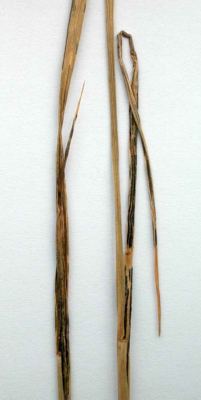Diseases
Urocystis tritici Koern. - Flag Smut.
Systematic position.
Fungus Urocystis tritici Koern. belongs to class Basidiomicetes, order Ustilaginales, family Tilletiaceae, genus Urocystis.Biological group.
Obligate parasite.Morphology and biology.
Narrow strips (from 2 mm to several cm in length) are formed on leaves, leaf sheaths and occasionally on culms. Numerous black teliospores are produced when the streaks are fissured. The spores staying on the seed or in the soil infect germinating kernels or very young seedlings. The disease continues to develop systemically through a plant. Teliospores are black-brown balls, nearly spherical, 20-45 x 12-38 . in diameter, having 2-8 spores within a sheath of hyaline-flattened sterile cells. After a month of dormancy the teliospores germinate to form a short promycelium and the basidia with 2-4 cylindrical sporidia (basidiospores). Teliospores can survive no more than one year in soil, and no more than 5 years in herbarium and on seeds. Flag Smut becomes apparent on leaves in spring and summer. Diseased plants are usually stunted excessively. Leaves may be twisted laterally, and heading may be prevented. Heads that emerge have striped glumes and necks. Bread wheat is the primary host of flag smut fungi. Nevertheless, there are a few reports of flag smut subsistence on durum wheat and other cereals. Flag smut fungi differ markedly among specific hosts.Distribution.
The disease is found in wheat growing areas of the Middle Asian countries (Azerbaijan, Turkmenistan, Kirghizia, and Kazakhstan) and Georgia. Flag smut rarely occurs in Stavropol, Krasnodar Territories, and the Crimea.Ecology.
Low soil moisture (10-15%) and low soil temperatures (10-20 .C) favor infection. Air temperature 18-24.C (min/max 5-32.C) and a humidity of 60% are optimal for spore germination.Economic significance.
Flag smut is generally not an economically important disease. The harmfulness of the disease is related to decrease of plant growth, formation of smaller number of leaves, and decrease of their size. Diseased plants produce yield by 5 times less, compared to healthy plants. As a rule, an average percent of attacked plants corresponds in general to percent of yield losses. Seed dressing by fungicides, rotation with non-cereal crops, and use of resistant cultivars may overcome the disease development.Reference citations.
Peresipkin V.F. 1969. Flag smut. In: Agricultural Phytopathology. Moscow. 10-11 p. (In Russian)© Gagkaeva T.Yu.


